15 0 0 0 歯の比較解剖学
- 著者
- 後藤仁敏 大泰司紀之編
- 出版者
- 医歯薬出版
- 巻号頁・発行日
- 1986
13 0 0 0 OA 骨の起源と進化(<特集>人類の起源)
- 著者
- 後藤 仁敏
- 出版者
- バイオメカニズム学会
- 雑誌
- バイオメカニズム学会誌 (ISSN:02850885)
- 巻号頁・発行日
- vol.21, no.4, pp.157-162, 1997-11-01 (Released:2016-11-01)
- 参考文献数
- 24
- 被引用文献数
- 1
8 0 0 0 日本産ラブカ科の歯化石とラブカ類の系統と古生態
- 著者
- 後藤 仁敏 サメの歯化石研究会
- 出版者
- 地学団体研究会
- 雑誌
- 地球科學 (ISSN:03666611)
- 巻号頁・発行日
- vol.58, no.6, pp.361-374, 2004-11-25
- 参考文献数
- 48
- 被引用文献数
- 3
現生のラブカChlamydoselachus anguineusは,現生板鰓類のなかで最も原始的な解剖学的特徴を残したサメである.これまでの記録では,ラブカ科の最古の化石は南極のジェームスロス島の白亜紀後期(Campanian)の地層から産出したChlamydoselachus thomsoniであった.本論文では,日本産のラブカ属12本の歯化石にもとづく6種を記載した.すなわち,白亜紀後期(Turonian〜Maastrichtian)の地層から5種(10標本),第三紀中新世の地層から1種(2標本)である.Chlamydoselachus sp. 1の小型の歯は北海道三笠市の上部蝦夷層群(Turonian-Coniacian)と,夕張市鹿島の上部蝦夷層群(Santonian)から産出した.Chlamydoselachus sp. 2の小型の歯とChlamydoselachus sp. 3の大型の歯は,熊本県天草郡竜ケ岳町の姫浦層群樋之島層(Santonian)から産出した.Chlamydoselachus sp. 4の大型の歯とChlamydoselachus sp. 5の超大型の歯は大阪府貝塚市と泉南市昭和池の和泉層群畦ノ谷層(Maastrichtian)から産出した.Chlamydoselachus bracheriの歯は,群馬県富岡市の富岡層群井戸沢層(前期中新世)と同県安中市の富岡層群原田篠層(中期中新世)から産出した.また,ラブカ類の系統発生的関係と古環境の変化について考察した.すなわち,白亜紀後期には大型から小型のラブカ類が浅い海に生息していたのに,中新世になると比較的深い海に中型以下のラブカが棲むようになったことが推定される.
6 0 0 0 OA 日本産ラブカ科の歯化石とラブカ類の系統と古生態
- 著者
- 後藤 仁敏 サメの歯化石研究会
- 出版者
- The Association for the Geological Collaboration in Japan
- 雑誌
- 地球科学 (ISSN:03666611)
- 巻号頁・発行日
- vol.58, no.6, pp.361-374, 2004-11-25 (Released:2017-07-14)
- 被引用文献数
- 1
現生のラブカChlamydoselachus anguineusは,現生板鰓類のなかで最も原始的な解剖学的特徴を残したサメである.これまでの記録では,ラブカ科の最古の化石は南極のジェームスロス島の白亜紀後期(Campanian)の地層から産出したChlamydoselachus thomsoniであった.本論文では,日本産のラブカ属12本の歯化石にもとづく6種を記載した.すなわち,白亜紀後期(Turonian〜Maastrichtian)の地層から5種(10標本),第三紀中新世の地層から1種(2標本)である.Chlamydoselachus sp. 1の小型の歯は北海道三笠市の上部蝦夷層群(Turonian-Coniacian)と,夕張市鹿島の上部蝦夷層群(Santonian)から産出した.Chlamydoselachus sp. 2の小型の歯とChlamydoselachus sp. 3の大型の歯は,熊本県天草郡竜ケ岳町の姫浦層群樋之島層(Santonian)から産出した.Chlamydoselachus sp. 4の大型の歯とChlamydoselachus sp. 5の超大型の歯は大阪府貝塚市と泉南市昭和池の和泉層群畦ノ谷層(Maastrichtian)から産出した.Chlamydoselachus bracheriの歯は,群馬県富岡市の富岡層群井戸沢層(前期中新世)と同県安中市の富岡層群原田篠層(中期中新世)から産出した.また,ラブカ類の系統発生的関係と古環境の変化について考察した.すなわち,白亜紀後期には大型から小型のラブカ類が浅い海に生息していたのに,中新世になると比較的深い海に中型以下のラブカが棲むようになったことが推定される.
5 0 0 0 犬になった王子 : チベットの民話
本研究は大きく分けて(1)マルチ分子オブジェクト法のための分子計算プラットフォームの構築、(2)階層化分子シミュレーションのための分子計算技術の開発、(3)不均一計算タスクの負荷分散アルゴリズムの開発、の3つの部分からなる。それぞれに関する研究実績の概要を以下に示す。(1)マルチ分子オブジェクト法による並列化効率と計算精度の向上を目指し,大規模系の結晶シミュレーション技術の開発を行った。その結果,分子間相互作用エネルギー和で14桁までの精度保障を実現すると伴に,およそ4億原子で構成された直径0.1μmもの分子性結晶計算に成功した.また、実用化レベルで結晶多形間の相転移シミュレーションによる熱力学解析法の開発に成功した.(2)マルチウェーブレット基底を用いたTDHF/TDDFT時間依存シュレディンガー方程式の解法や超分極率の算定法などの開発を行なった.これらは,現時点では大規模系への適用は容易ではないが,今後,不均一系に対する密度汎関数理論の開発へ展開することが大いに期待できる結果となった.(3)分子シミュレーションの計算タスクに対して演算性能が不十分なヘテロ分散計算環境では,実践的な負荷分散アルゴリズムは困難であることが分かった.そこで,分子シミュレーションに利用されることが多いマルチコアCPUをクラスター化したヘテロ分散環境を想定し,マルチコア/マルチスレッドシステムの負荷分散アルゴリズムめ開発に着手した.
4 0 0 0 OA 化石全骨魚類Pycnodontの歯に関する比較組織学的研究
- 著者
- 後藤 仁敏 井上 孝二
- 出版者
- Japanese Association for Oral Biology
- 雑誌
- 歯科基礎医学会雑誌 (ISSN:03850137)
- 巻号頁・発行日
- vol.21, no.4, pp.667-688, 1979 (Released:2011-08-10)
- 参考文献数
- 46
- 被引用文献数
- 1 1
西アフリカのマリ共和国において, 新生代第三紀始新世の地層から発見された, 化石全骨魚類のピクノドゥス類に属する魚の鋤骨一口蓋骨歯について, 歯の形態と配列状態に関する肉眼的観察, 研磨標本の光学顕微鏡的観察, マイクロラジオグラフィー, 走査電子顕微鏡的観察, および粉末試料のX線回折などの方法により, 歯を構成する硬組織の性質を検索した。鋤骨一口蓋骨の下面に歯はトウモロコシ状に, かなり不規則ではあるが11の歯列をなして配列している。歯の硬組織は, おもにリン灰石からなる鉱物質によって構成され, 厚い外層 (エナメル質) とその下の薄い内層 (象牙質) からなり, 内層は歯の辺縁部で下方に細長く突出しており, 本来の歯髄腔は骨組織によってみたされている。歯の外層は, X線透過度の低い高度に石灰化した硬組織で, 内層から連続する細管によって貫かれ, 深層部では叢状に密に交錯する結晶の束からなるが, 表層部では結晶が歯表に直角方向に平行に配列する状態に移行している。酸で脱灰すると外層の硬組織は溶解消失するが, 細管構造は残存してヘマトキシリンに染色される。歯の内層は, X線透過度の比較的高い層で, 脱灰標本ではヘマトキシリンに染色され, 象牙細管の存在する領域と, その周囲をとりまく線維骨様組織から構成されており, 前者の直下には分断された小さな歯髄腔が存在しているが, 後者は本来の歯髄腔をみたす骨組織に移行している。歯の外層と内層との境界は明瞭であるが, 歯の内層と周囲の骨組織とは移行的で, 歯は骨組織と骨性結合により固く支持されている。このような歯の配列状態, 組織構造, 支持様式は, この魚がピクノドゥス類のなかでも, 有殻軟体動物食に著しく適応した仲間であったことを, 示すものである。
4 0 0 0 OA 使える理論・情報・計算化学
- 著者
- 後藤 仁志
- 出版者
- 日本コンピュータ化学会
- 雑誌
- Journal of Computer Chemistry, Japan (ISSN:13471767)
- 巻号頁・発行日
- vol.13, no.2, pp.A5-A5, 2014-06-30 (Released:2014-06-30)
- 参考文献数
- 3
4 0 0 0 骨の起源と進化(<特集>人類の起源)
- 著者
- 後藤 仁敏
- 出版者
- バイオメカニズム学会
- 雑誌
- バイオメカニズム学会誌 (ISSN:02850885)
- 巻号頁・発行日
- vol.21, no.4, pp.157-162, 1997
3 0 0 0 OA 群馬県富岡市から発見されたアオザメ属の歯の化石について : 古生物
- 著者
- 大沢 澄可 小林 二三雄 後藤 仁敏
- 出版者
- 日本地質学会
- 雑誌
- 日本地質学会学術大会講演要旨
- 巻号頁・発行日
- vol.85, 1978-04-01
- 著者
- 山下 良子 神山 秀一 山本 明日香 加納 宏樹 結城 祥充 上田 晃 川本 由加里 後藤 仁和 山本 聡
- 出版者
- 公益社団法人 日本薬学会
- 雑誌
- YAKUGAKU ZASSHI (ISSN:00316903)
- 巻号頁・発行日
- vol.136, no.12, pp.1641-1649, 2016 (Released:2016-12-01)
- 参考文献数
- 28
- 被引用文献数
- 6
The efficacy of cefepime (CFPM) is known to depend on the ratio of the time that the serum levels exceed the minimum inhibitory concentration (MIC) to the dosing interval (%T>MIC). The objective of this study was to clarify the relation between %T>MIC and clinical outcome of CFPM, and to identify the optimal dosage regimen. We investigated the outcome of CFPM treatment for febrile neutropenia (FN) patients with normal renal function. Treatment success was defined as the completion of FN therapy with CFPM only. And we calculated %T>MIC for each case based on population pharmacokinetic parameters. The MIC value for simulation was set as 8 μg/mL. In logistic regression analysis, treatment success was significantly associated with the elevation of %T>MIC in the group with persistent neutropenia, yielding a receiver operating characteristic curve with an optimal cutoff value of 73.1%. Next, we simulated %T>MIC for each case under various dosing regimens. For patients whose creatinine clearance (CLcr) exceeded 100 mL/min, it was found to be difficult to attain the objective under the current regimen. In contrast, it was calculated that treatment with 2 g three times a day (t.i.d.) could attain the objective for most of the patients with 3 h of infusion. These results suggest that CFPM treatment under the current regimen is ineffective for FN patients with normal or augmented renal function, and that 2 g t.i.d. is necessary in quite a lot cases, although such use is off-label.
3 0 0 0 ながいかみのむすめチャンファメイ : 中国・侗族の民話
2 0 0 0 OA 三木成夫の生涯と業績
- 著者
- 後藤 仁敏
- 出版者
- ゲーテ自然科学の集い
- 雑誌
- モルフォロギア: ゲーテと自然科学 (ISSN:0286133X)
- 巻号頁・発行日
- vol.1994, no.16, pp.30-51, 1994-11-03 (Released:2010-02-26)
- 参考文献数
- 12
2 0 0 0 IR 琺瑯質かエナメル質か、間葉性エナメル質かエナメロイドか
- 著者
- 後藤 仁敏
- 出版者
- 鶴見大学
- 雑誌
- 鶴見大学紀要. 第3部, 保育・歯科衛生編 (ISSN:03898024)
- 巻号頁・発行日
- no.51, pp.71-86, 2014-03
現在ではヒトをはじめとする哺乳類の歯の組織について、「エナメル質」「セメント質」「歯肉」というのが一般であるが、かつて日本では、「琺瑯質(ほうろうしつ)」「白亜質(はくあしつ)」「歯齦(しぎん)」という用語が使用されていた。事実、私が若い頃は、東京歯科大学の先生方は、「琺瑯質」「琺瑯質稜柱」「琺瑯芽細胞」という用語を使用されていた。私は、なぜ、東京歯科大学の先生だけがこのような「間違った」用語を使用するのか理解できず、不思議に感じていた。しかし、その後、調査した結果、じつは「間違った」のは私たちで、かつて1940年代までの日本では「琺瑯質」などの用語が一般であったことを知った。「エナメル質」が用いられ始めたのは1950年代からで、藤田(1957)以降急速に普及した。しかし、鶴見大学歯学部では松井隆弘教授により1981年まで「ほうろう質」が、東京歯科大学では1994年まで「琺瑯質」が使用され、それ以後「エナメル質」に変わっている。その経過と原因について追究した結果を報告したい。また、魚類の歯の外層については、「象牙質(dentine)」「硝子象牙質(vitorodentine)」「硬象牙質(durodentine)」「変化象牙質(modified dentine)」とか、「エナメル質(enamel)」「中胚葉性エナメル質(mesodermal enamel)」「間葉性エナメル質(mesenchyal enamel)」「エナメロイド(enameloid)」とか呼ばれてきた。私も、かつては「間葉性エナメル質」(後藤, 1976, 78, 88; 後藤・大泰司,1986)を使用していたが、最近は「エナメロイド(enameloid)」(後藤, 1987, 96, 99; 後藤ほか,2014)を使用するようになった。その経緯と、理由について述べる次第である。
- 著者
- 後藤 仁敏
- 出版者
- 日本地質学会
- 雑誌
- 地質學雜誌 (ISSN:00167630)
- 巻号頁・発行日
- vol.103, no.12, pp.1203-1204, 1997-12-15
- 著者
- 五十里 洋行 後藤 仁志 小林 祐司 藤原 聖史
- 出版者
- 公益社団法人 土木学会
- 雑誌
- 土木学会論文集B2(海岸工学) (ISSN:18842399)
- 巻号頁・発行日
- vol.75, no.2, pp.I_853-I_858, 2019 (Released:2019-10-17)
- 参考文献数
- 15
- 被引用文献数
- 1
大規模な津波が海岸堤防を越流する際には裏法肩近傍において顕著な圧力低下が生じ,それによって被覆ブロックが離脱・流出することが知られている.本現象の再現計算においては,激流中を運動するブロックを追跡する必要があり,これまでに十分に再現可能な三次元数値モデルは存在しなかった.そこで,本研究では,移動物体の追跡の容易な粒子法を用いた数値モデルの開発を行う.本数値モデルでは,極端な負圧の発生によるtensile instabilityに対応するために圧力ノイズの低減を目的とした高精度スキームを導入するが,それに若干の修正を加えることで計算時間を5~6割程度に短縮した.本数値モデルの適用により,堤防裏法面に設置された被覆ブロックが堤越流の作用によって回転しながら離脱・流出する過程が良好に再現された.
2 0 0 0 OA ヒトのネオテニー説批判
- 著者
- 井尻 正二 秋山 雅彦 後藤 仁敏
- 出版者
- 地学団体研究会
- 雑誌
- 地球科学 (ISSN:03666611)
- 巻号頁・発行日
- vol.45, no.1, pp.1-18, 1991-01-25 (Released:2017-06-06)
The purpose of this paper is to indicate a biological misunderstanding on the neoteny doctrine and a danger of the biological determinism inevitably included in the doctrine. The neoteny doctrine discussed in this paper is used in a broad sense, including Bolk's fetalization, Montagu's neoteny and Gould's retardation theories. A general understanding of the term (concept) of neoteny is a mixture of the above-mentioned three, though exemplifications of their characters for neoteny are not always same. Morphogenesis is classified into the following eight types by de Beer; 1) caenogenesis, 2) deviation, 3) neoteny, 4) reduction, 5) adult variation, 6) retardation, 7) hypermorphosis, and 8) acceleration. According to this classification, Bolk's fetalization and Montagu's neoteny correspond to neoteny, and Gould's retardation is to retardation and neoteny. Anatomical characters of Homo sapiens are enumerated in Table 1, where characters identified as neoteny by Bolk, Montagu and Gould are marked with circles. However, the critique of the neoteny doctrine should be focused on the anatomical characters for bipedal walk in erect posture, since this posture is the most important biological character of Homo sapiens. Bipedal walk in erect posture consists of erect posture, bipedalism and walk. The most fundamental characters are sigmoidal flexure of a vertebral column for erect posture, shape of a pelvis for bipedalism, and plantar arches for walk. If the neoteny doctrine is correct, those fundamental characters of Homo sapiens should appear in fetus or infant stages of anthropoids. Anatomical and comparative embryological examinations reveal that those characters are not observed in these stages. It is, therefore, concluded that the above-mentioned characters of Homo sapiens do not support the neoteny doctrine. Since the fundamental characters of Homo sapiens do not support neoteny, discussion on the other characters hitherto related to neoteny seems to be unnecessary. However, we discussed such characters as cranium, cranial flexure and direction of vagina so far regarded to be representative for neoteny, and proved that these characters are not to be neoteny. All of those who support the neoteny doctrine of Homo sapiens believe the human body as a perfect (harmonic) reality without any contradiction and are, at the same time, lacking in historical (geohistorical or phylogenic) viewpoints to human body constituent organs. Moreover, the neoteny doctrine originates in neglect or disregard of the importance of 'human society' in the course of humanization of the genus Homo. Lastly, we discussed the background for the birth of the neoteny doctrine and suggested the existence of biological determinism behind. We insist that organically unified natural and social sciences could become only the science in the 21 century.
2 0 0 0 OA 科学を求め続ける『フォース』
- 著者
- 後藤 仁志
- 出版者
- 日本コンピュータ化学会
- 雑誌
- Journal of Computer Chemistry, Japan (ISSN:13471767)
- 巻号頁・発行日
- vol.15, no.1, pp.A1-A2, 2016 (Released:2016-04-25)
2 0 0 0 OA 粗視化ポテンシャルを用いたタンパク質四次構造の高速安定性評価
- 著者
- 柄本 涼介 榎本 大義 後藤 仁志
- 出版者
- 公益社団法人 日本化学会・情報化学部会
- 雑誌
- ケモインフォマティクス討論会予稿集 第39回ケモインフォマティクス討論会 浜松
- 巻号頁・発行日
- pp.P11, 2016 (Released:2016-09-22)
- 参考文献数
- 9
生体内で機能しているタンパク質の多くは四次構造を形成している。この構造を予測するタンパク質ドッキングには,タンパク質間相互作用を高速に評価する手法が重要である。これまでの我々の研究において,Krishnamoorthy等らが開発した統計的粗視化ポテンシャルや,我々によるその改良ポテンシャルをスコア関数に採用したタンパク質―ペプチドリガンド複合体の高速構造探索(ペプチドリガンドドッキング)法を開発してきた。本研究では,これらの粗視化ポテンシャルをタンパク質四次構造の安定性評価に適用できるかどうか検討するため,ホスホフルクトキナーゼ四量体の多形構造を生成し,それらをAMBER力場と粗視化ポテンシャルを用いて比較した。
2 0 0 0 高波浪による消波ブロック群高密度化のメカニズム
- 著者
- 後藤 仁志 原田 英治 高山 知司 水谷 雅裕 不動 雅之 岩本 晃幸
- 出版者
- Japan Society of Civil Engineers
- 雑誌
- 海岸工学論文集 (ISSN:09167897)
- 巻号頁・発行日
- vol.52, pp.781-785, 2005
本稿では, 大波浪の襲来を受ける外洋に直面する防波堤周辺に設置された消波ブロック群の沈下機構の一つとして, 波力によるブロック群の高密度化に関して, 現地計測と数値シミュレーションの両面から検討する. 水面下のブロック群低脚部の時化後のブロック配置をマルチビームソナーにより計測し, 消波ブロック群支持層の沈下の有無を明らかにするとともに, 個別要素法型の3Dブロックモデルを用いた数値シミュレーションによって, ブロック群の高密度化過程を計算力学的に検討する.







